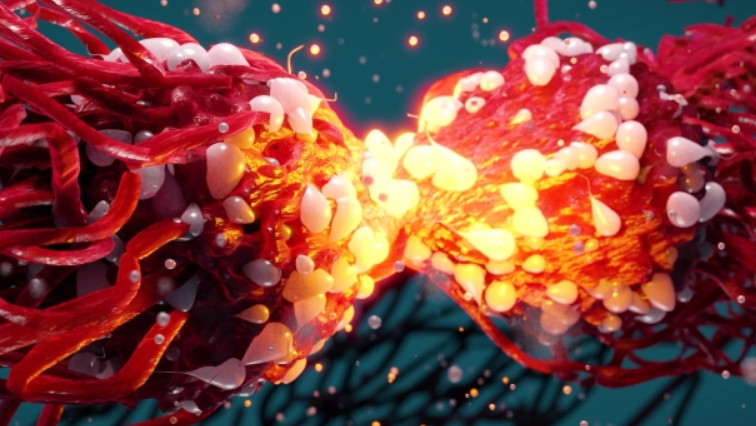Nanotheranostics is an emerging field that promises to provide new and innovative medical solutions that will address unmet medical needs in cancer management and offers the next generation cancer management tool that merges both therapy and diagnostics in one system. Clinically, nanotheranostic approaches promise to diagnose and treat cancer simultaneously, to monitor anticancer response and disease progression in real-time, at the molecular level.
Graphene-based nanotechnology
The use of graphene-based materials in pharmaceutical nanotechnology has recently received more attention due to their unique chemical structure and physicochemical properties—including an ultra-high surface area, optical, thermal and electrical conductivities, and a good biocompatibility.
Graphene-based materials are composed of graphene and graphene oxide (GO) and/or graphene derivatives. Graphene is a single atom-thick layer of sp2 hybridised carbon atoms arranged in a two-dimensional (2D) lattice, while GO is its oxidised counterpart. In addition, graphene is the basic building block of several other carbon allotropes, including graphite, charcoal, and carbon nanotubes.
GO nanosheets tend to be hydrophilic and the surface contains reactive groups for an increased functionality or for loading drugs through covalent and non-covalent interactions. In addition, graphene-based nanomaterials can also be functionalised with diagnostic probes that have fluorescent and/or luminescent properties and can target ligands such as proteins, peptides, nucleic acids, antibodies, lipids, carbohydrates and folic acid.
In pharmaceutical applications, graphene-based nanomaterials possess a lot of potential for improving drug circulation times, in target drug and gene delivery systems, for acting as therapeutic agents and diagnostic tools, as well as nanotheranostic agents that combine both diagnostic and therapy approaches in a single system.
Graphene-based nanotheranostics
Graphene-based nanomaterials have a good biocompatibility (if functionalised), biodegradability and multi-functionalities, which makes them suitable candidates for cancer nanotheranostics. They can also load large amounts of drug molecules on both sides of the single atom layer sheet.
In a drug delivery system, graphene-based nanomaterials have shown the capability to carry and deliver different therapeutic agents such as small drug molecules, genes and deoxyribonucleic acid (DNA). In a recent study, Pei and co-workers have successful engineered a dual-drug-loaded pegylated nano-graphene oxide to deliver mixed anticancer drugs, cisplatin (PT) and doxorubicin (DOX) in one system to improve anticancer activity.
In a similar study by Dr Andrea Lucherelli and co-workers, they reported that they had also successfully engineered a multi-functional graphene-based nanomaterial, functionalised with doxorubicin, Indocyanine green and folic acid. The proposed multi-functional graphene-based nanomaterials enhanced anticancer activity via a multi-functional approach.
The advantage of using functionalised graphene-based nanomaterials with folic acid—a targeting agent—was to enhance the delivery of anticancer (i.e. DOX) to the targeted cancer cells or to where it will be most effective, in this case in the nucleus.
In a clinical setting, targeted drug delivery system approaches can reduce the frequency of drug administration to the patient, reducing the number of systemic adverse side effects and improving drug efficacy. In addition, it will lead into fewer medications, lower costs, better medication, and ultimately, better patient compliance.
The advantage of using functionalised graphene-based nanomaterials with indocyanine green—a fluorescent probe—is to track the cellular uptake and/or internalisation of the anticancer drug inside the targeted cancer cells. In an in-vivo and/or clinical setting, functionalised graphene-based nanomaterials with a fluorescent probe, or imaging agent, can assist in monitoring the cancer treatment and perform diagnostics in real-time—with just the administration of a one-unit system.
Light-based cancer therapy
Another exciting application for graphene-based nanomaterials lies withing light-based therapy. Light-based therapy, or phototherapy such as photothermal therapy (PTT) and photodynamic therapy (PDT), can treat a variety of diseases, including cancer, by employing a specific light irradiation. Due to the physicochemical properties of optical absorption in the near-infrared light region, researchers are utilising graphene-based nanomaterials as a photothermal agent against cancer.
The anticancer mechanism of graphene-based nanomaterials involves inducing thermal and oxidative stresses to the cancer cells and/or tumour tissues. PTT procedures employ an optical-absorbing agent to generate heat under light irradiation to destroy the cancerous tissue and/or cells. PDT procedures requires a photosensitiser and a light source at specific wavelengths, which leads to the induction of cytotoxic reactive oxygen species (ROS) that results in irreversible damage to the cancer cells and/or tumour tissue.
Because of their optical properties, graphene-based nanomaterials can be used as a cancer theranostic agent, combining both phototherapy and imaging modalities in one system, to monitor the distribution of therapeutic agents and for bio-imaging tumour tissue growth in real-time.
The next generation of cancer nanotheranostics employing graphene-based nanomaterials could address the many challenges associated with traditional chemotherapeutic agents, such as the issues surrounding poor solubility, harmful side effects, non-specific drug distribution, and multi-drug resistance (MDR). In addition, it will also offer an effective multifunctional biomedical system, a 5-in-1 system that will consist of dual drug delivery, a combined two-chemotherapy approach (e.g. PT and DOX), phototherapy (PTT or PDT), a diagnostic or imaging agent (e.g. fluorescent or luminescent probe), and a nanomaterial that has a good biocompatibility—all in one system.
Read the original article on Nanowerk.







